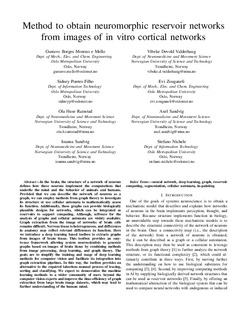| dc.contributor.author | Mello, Gustavo | |
| dc.contributor.author | Pontes-Filho, Sidney | |
| dc.contributor.author | Sandvig, Ioanna | |
| dc.contributor.author | Valderhaug, Vibeke Devold | |
| dc.contributor.author | Zouganeli, Evi | |
| dc.contributor.author | Huse Ramstad, Ola | |
| dc.contributor.author | Sandvig, Axel | |
| dc.contributor.author | Nichele, Stefano | |
| dc.date.accessioned | 2020-03-03T13:15:28Z | |
| dc.date.available | 2020-03-03T13:15:28Z | |
| dc.date.created | 2020-03-02T12:39:45Z | |
| dc.date.issued | 2020 | |
| dc.identifier.isbn | 978-1-7281-2484-1 | |
| dc.identifier.uri | http://hdl.handle.net/11250/2644970 | |
| dc.description.abstract | In the brain, the structure of a network of neurons defines how these neurons implement the computations that underlie the mind and the behavior of animals and humans. Provided that we can describe the network of neurons as a graph. We can employ methods from graph theory to investigate its structure or use cellular automata to mathematically assess its function. Additionally, these graphs can provide biologically plausible designs for networks, which can be integrated as reservoirs to support computing. Although, software for the analysis of graphs and cellular automata are widely available. Graph extraction from the image of networks of brain cells remains difficult. Nervous tissue is heterogeneous, and differences in anatomy may reflect relevant differences in function. Here we introduce a deep learning based toolbox to extracts graphs from images of brain tissue. This toolbox provides an easy- to-use framework allowing system neuroscientists to generate graphs based on images of brain tissue by combining methods from image processing, deep learning, and graph theory. The goals are to simplify the training and usage of deep learning methods for computer vision and facilitate its integration into graph extraction pipelines. In this way, the toolbox provides an alternative to the required laborious manual process of tracing, sorting and classifying. We expect to democratize the machine learning methods to a wider community of users beyond the computer vision experts and improve the time-efficiency of graph extraction from large brain image datasets, which may lead to further understanding of the human mind. | nb_NO |
| dc.language.iso | eng | nb_NO |
| dc.publisher | Institute of Electrical and Electronics Engineers (IEEE) | nb_NO |
| dc.relation.ispartof | Proceedings of IEEE Symposium Series on Computational Intelligence (SSCI2019) | |
| dc.relation.uri | https://ieeexplore.ieee.org/abstract/document/9002741 | |
| dc.title | Method to Obtain Neuromorphic Reservoir Networks from Images of in Vitro Cortical Networks | nb_NO |
| dc.type | Chapter | nb_NO |
| dc.description.version | acceptedVersion | nb_NO |
| dc.source.pagenumber | 2360-2366 | nb_NO |
| dc.identifier.doi | https://doi.org/10.1109/SSCI44817.2019.9002741 | |
| dc.identifier.cristin | 1798914 | |
| dc.relation.project | Norges forskningsråd: 270961 | nb_NO |
| dc.description.localcode | © 2020 IEEE. Personal use of this material is permitted. Permission from IEEE must be obtained for all other uses, in any current or future media, including reprinting/republishing this material for advertising or promotional purposes, creating new collective works, for resale or redistribution to servers or lists, or reuse of any copyrighted component of this work in other works. | nb_NO |
| cristin.unitcode | 194,65,30,0 | |
| cristin.unitname | Institutt for nevromedisin og bevegelsesvitenskap | |
| cristin.ispublished | false | |
| cristin.fulltext | postprint | |
